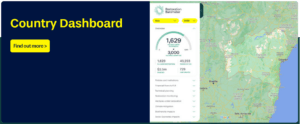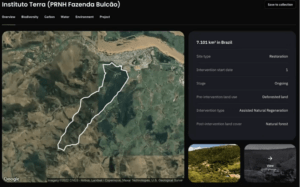Two major UN climate and biodiversity meetings last year, COP27 and the long-awaited COP15, concluded with more commitments to address climate change and biodiversity loss through forest restoration.
The critical role of nature and ecosystem restoration is being increasingly recognized as central to meeting the 1.5°C target of the Paris Agreement to limit global warming. Nations have also agreed to protect a third of the planet for nature by 2030, in a landmark deal aimed at safeguarding biodiversity.
There remains, however, an important funding gap on nature-based solutions, such as forest conservation and ecosystem restoration, and an urgent need to turn commitments into leadership and action.
It’s important that companies share examples of how they are contributing to conserving and restoring landscapes, and demonstrate the impacts on communities and nature. Sharing these stories transparently can inspire the global community to learn, act, improve and increase ambition.
The 10 World Restoration Flagships announced at COP15 are the most ambitious and inspirational examples of supporting nature. They demonstrate collaborative approaches and share best practice. From these examples, decision-makers can be informed of what works and what doesn’t – inspiring them to take bigger and better action.
A way to measure actual restoration progress
 The IUCN Restoration Barometer is a tool that tracks the implementation of restoration commitments across ecosystems, from forests to farmlands and from waterways to coasts. It simplifies reporting and builds a comprehensive picture of progress, including the key steps to success, and identifies gaps in resources to maximize future efforts.
The IUCN Restoration Barometer is a tool that tracks the implementation of restoration commitments across ecosystems, from forests to farmlands and from waterways to coasts. It simplifies reporting and builds a comprehensive picture of progress, including the key steps to success, and identifies gaps in resources to maximize future efforts.
In 2021-2022 it was used by 22 governments and endorsed by over 50. It also tracks progress towards national and global goals, such as the Global Biodiversity Framework and the UN Decade on Ecosystem Restoration, providing quantified assessment of positive impacts on biodiversity conservation, climate mitigation and economic growth.
At COP15, IUCN launched the 2022 Restoration Barometer report with the results of the recent country application as well as a new country dashboard to further simplify reporting.
Through a collaboration with the One Trillion Trees initiative (1t.org), the Barometer’s framework was adapted for the private sector to support companies in reporting the implementation progress of their conservation and restoration pledges. Since the launch of the 1t.org pledge process, over 80 companies have pledged to conserve, restore and grow more than 7 billion trees in over 65 countries.
 The Barometer’s four action indicators (policies and strategies, funding, technical planning and monitoring) and four impact indicators (area of land, climate, biodiversity, economy) enable companies to annually report on their restoration interventions, highlighting the qualitative and quantitative measures of progress and helping them to align their projects with ecosystem restoration and forest landscape restoration principles.
The Barometer’s four action indicators (policies and strategies, funding, technical planning and monitoring) and four impact indicators (area of land, climate, biodiversity, economy) enable companies to annually report on their restoration interventions, highlighting the qualitative and quantitative measures of progress and helping them to align their projects with ecosystem restoration and forest landscape restoration principles.
This year, 30 companies with an active 1t.org pledge, many of them members of the 1t.org Corporate Alliance, are leading the way by sharing data on their project progress and the restoration impact.
Some 85% of companies report being on track to fulfil their restoration commitments, demonstrating progress against the key indicators of the Barometer, sharing detailed information on how they are planning restoration projects, and the benefits they are yielding.
While 1t.org pledges focus on trees and forest landscapes, application of the Barometer revealed that their restoration work takes place in many different ecosystems, as also including coasts, farmlands, grasslands, peatlands and urban areas.
EY is one such company actively implementing its pledge across continents and ecosystems as part of its wider sustainability strategy. With their partner South Pole, they are removing CO2 from the atmosphere through high-quality reforestation, as well as restoring degraded landscapes through agroforestry to improve biodiversity and support livelihoods of local communities in countries such as China, Uruguay and Zimbabwe.
Nestlé, as part of their Global Reforestation Program, is working within their supply chain to help restore land key to the livelihoods of farming communities that could face degradation.
In the Philippines, Nicaragua, Colombia and Honduras, they are planting native tree species in areas connected to where their key ingredients are produced, including their coffee sourcing farms and supply sheds. Finally, the projects also include early and long-term monitoring systems to track growth and take adaptive measures.
AstraZeneca, through its AZ Forest initiative, has planted over ten million trees to date including in Ghana, Indonesia, Australia and the UK, and is on track to meet its 2025 target to plant and maintain 50 million trees. AZ Forest is investing in agroforestry systems to support sustainable livelihoods, developing woodlots to help tackle the drivers of forest degradation and strategically targeting project areas to improve connectivity between key habitats.
Their science-led approach is grounded in partnerships at the community, national and global level, and engagement with local stakeholders has been key to designing projects valued and sustained by local people.
While, on average, companies provided responses to more indicators than required, very few were able to provide data on all indicators and more than 50% of companies provided data at a global, aggregate scale. This shows the need to continue working with stakeholders to support them in identifying, collecting and sharing more data on key metrics such as area under restoration at a more detailed level to provide a fuller picture of progress.
A global hub for ecosystem restoration
Companies are also integrating geospatial data – information that represents features or objects on the Earth’s surface – to show visual evidence of their efforts. Through platforms such as Restor, companies are gaining valuable insights to plan, implement, monitor and report against their approaches. As Restor is an open-science platform, it also functions as a public disclosure and showcase platform for corporate ecosystem restoration leaders, inspiring other businesses to act.
Companies and other users of the platform create their own profile that aggregates information and ecological insights (such as on climate, biodiversity and water), across project sites, enabling them to manage their projects and collaborate with relevant partners to track progress and impact.
As a monitoring partner of 1t.org, Restor supports the global restoration movement by driving transparency and building wide communities of stakeholders, from field practitioners and tree nursery developers to funding organizations, with 130,000 restoration projects currently hosted on their geospatial platform.
Zurich Insurance Group, for example, will add data of locally sponsored projects in addition to their group-wide collaboration with Instituto Terra on Restor, to help them obtain more verifiable and trustworthy data for improved progress and impact monitoring. As an insurance company with expertise on risk, topics such as carbon and biodiversity are particularly important – not only for their customers and society, but also for the development of credible voluntary carbon markets.
Transparency is key for companies to be accountable, but also helps inspire others to take action. Restor’s platform allows Zurich to add in its additional projects from around the world and understand the accumulated impact, get an overview of engagement with local communities in different locations, as well as other companies that are involved in the same projects. This could lead to shared learnings and collaboration or synergy opportunities.
Expanding a community of restoration action
As the world nears critical ecological tipping points, more commitments are needed with evidence of action. 2023 is the year of showing examples of implementation, highlighting and being transparent about challenges.
Adani and Meta are two of the most recent companies to pledge to 1t.org, respectively committing to grow 100 million trees by 2030, and partnering with the National Indian Carbon Coalition to build on the important success factor that is Indigenous Peoples leadership. Both companies will track their project development and impact to offer data climate, nature and social benefits.
Through 1t.org’s ongoing partnerships and joint collaboration with the IUCN Restoration Barometer and Restor, companies are enable to take better informed decisions and more transparent impact reporting.
While the community of restoration investors continues to grow, trusted mechanisms to showcase progress and learnings such as these must grow for best practices to become commonplace and to achieve meaningful impact for communities, nature and the climate.
Photo of Kariba Forest Protection effort in Zimbabwe courtesy of EY.
See One Trillion Trees website.
This article by Ian Gunderson (Impact Specialist, 1t.org, World Economic Forum), Stephanie Feeney (Head of Partnerships, Restor) and Swati Hingorani (Senior Programme Officer, IUCN: International Union for Conservation of Nature) originally apperaed on the website of the World Economic Forum. Reprinted here (with minor edits) by permission.

